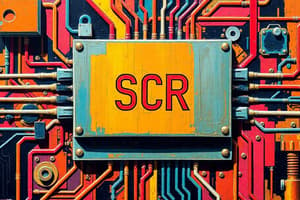Podcast
Questions and Answers
What is the basic configuration of a thyristor?
What is the basic configuration of a thyristor?
PNPN
What is the purpose of a crowbar circuit involving thyristors?
What is the purpose of a crowbar circuit involving thyristors?
To protect against power supply malfunctions
What is the characteristic of a Shockley diode that allows it to switch into conduction?
What is the characteristic of a Shockley diode that allows it to switch into conduction?
Passing a sufficient current
When does a Shockley diode conduct in an AC waveform?
When does a Shockley diode conduct in an AC waveform?
What improvement does an SCR have over a Shockley diode?
What improvement does an SCR have over a Shockley diode?
In what state do SCRs operate when conducting?
In what state do SCRs operate when conducting?
How can SCRs be turned off?
How can SCRs be turned off?
How can you test an SCR with a multimeter?
How can you test an SCR with a multimeter?
What is the difference between a Diac and an SCR in terms of switching on an AC waveform?
What is the difference between a Diac and an SCR in terms of switching on an AC waveform?
What is the purpose of the circuit composed of four transistors discussed in the text?
What is the purpose of the circuit composed of four transistors discussed in the text?
Flashcards are hidden until you start studying
Study Notes
- Thyristors are four-layer devices with a PNPN configuration, including the silicon unilateral switch (Shockley), silicon controlled rectifier (SCR), Diac, and Triac.
- Thyristors are commonly used in power control systems like crowbar circuits for power supply malfunctions and power control for devices like motors or lamps.
- The Shockley diode is a basic thyristor with a PNP structure that switches into conduction once a sufficient current passes through.
- The break over voltage is fixed in a Shockley diode, making it conduct only on the positive alternation of an AC waveform.
- The SCR is an improved version of the Shockley diode with a gate that allows for earlier break over by controlling the current flow.
- SCRs operate in saturation when conducting, leading to a low voltage drop across the device and efficient power management.
- Anode interruption and forced commutation are methods used to turn off SCRs by interrupting the current flow.
- A practical demonstration with an SCR circuit shows how adjusting the gate current affects the conduction of the device.
- Testing an SCR can be done with a multimeter by applying a voltage to trigger conduction between the anode and gate.
- The Diac is another thyristor device that allows for switching on both alternations of an AC waveform without a gate for adjustment.- The text discusses a circuit composed of four transistors arranged in a specific configuration for controlling alternating currents.
- The circuit functions similarly to a Shockley diode, allowing current flow based on break over voltage and holding current values.
- It is mentioned that the circuit can handle positive and negative alternations, with break over points occurring at specific times for each.
- To achieve better control over break over voltages, a triac can be used, which consists of two SCRs in a complementary setup.
- The asymmetry between positive and negative alternations in the triac circuit can lead to noise generation and other issues.
- The text suggests using closely matched SCRs in a complementary configuration to overcome the asymmetry problem.
- Future topics mentioned include the Uni Junction transistor and programmable Uni Junction transistor, with a potential shift towards discussing op amps.
Studying That Suits You
Use AI to generate personalized quizzes and flashcards to suit your learning preferences.




